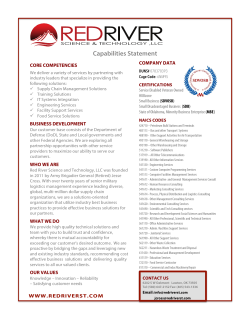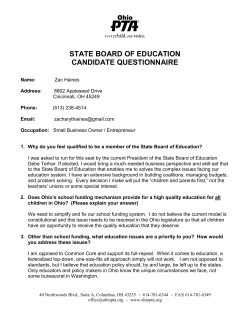
Ohio Horizontal Well Sites: Past History and Future Regulations
Ohio Horizontal Well Sites: Past History and Future Regulations Source: ALL 2014 Authors: Blake Arthur, PE , Kevin Shepard, PE, and J. Daniel Arthur, P.E., SPEC, ALL Consulting Introduction • 27 Horizontal Drilling Rigs & 10 Conventional Rigs (Mar-2015) • 64000 Oil and Gas wells Source: Ohio Oil and Gas Association (OOGA), 2014 Source: Ohio Department of Natural Resources (ODNR) – Division of Oil and Gas (DOGRM), 2013 May 5, 2015 2 Utica Well Activity in Ohio Source: DOGRM, 2014 May 5, 2015 3 Ohio Well Pad Activity (As of Nov. 2014) • 12-18 Companies Building Well Pads • 150-200 Well Pads planned for 2015 • 178 Well Pads with Producing Utica Wells • 300 Well Pads with Permitted Only Utica Wells • 30 Well Pads with Stratigraphic Tests ***ALL was involved with the design or construction of 86 well pads in 2014, while operating within the draft well pad rules.*** May 5, 2015 Source: ALL Consulting 4 Ohio Department of Natural Resources Division of Oil and Gas • Ohio Department of Natural Resources’ (ODNR) unique role in the oil & gas industry defined in Ohio Revised Code - 1509.02 “There is hereby created in the department of natural resources the division of oil and gas resources management, which shall be administered by the chief of the division of oil and gas resources management. The division has sole and exclusive authority to regulate the permitting, location, and spacing of oil and gas wells and production operations within the state… ” • Except for all of the other agencies: May 5, 2015 5 Evolving Regulations In Response to Horizontal Shale Development: • Senate Bill 315 - 2012 • Well Construction Rules – 2012 • House Bill 59 - 2013 • House Bill 64 – 2015 (New Budget Bill) Current Division Rule Making • Horizontal Well Site Construction – Submitted to Common Sense Initiative (CSI) February 2014 – Joint Committee on Agency Rule Review (JCARR) in 2015 • Waste Facilities – Rule making mandated by House Bill 59 • SPCC (Spill Prevention, Control, and Countermeasure Plans) – Proposed state role in containment oversight • Simultaneous Operations – Specify drilling practices while drilling adjacent to producing wells. May 5, 2015 7 • Function of Lieutenant Governor’s Office • Reviews for Business Impact • Process takes 30-60+ days depending on complexity of the rule. Source: Governor’s Office, 2014 May 5, 2015 8 • Reviews for compliance with 6 state-mandated “prongs” May 5, 2015 9 History of the Well Pad Rule Mapped extents of the Utica Upshur-Guernsey-Westmoreland landslide prone soils Mine impacted lands Source: DOGRM, 2014 May 5, 2015 10 May 5, 2015 11 Rule Process: 1501:9-02-02 Construction Application Submittal 3 years (max) 10 + 15 days (Review + Sched) Construction Certification Production Landowner Waiver 2 years (max) No Site Review 30 days (Tech Review) Application Approval Spud Yes Yes No Restoration Site Release (Non-O&G) If certification is not maintained, prior to spudding, restoration or landowner waiver acceptable to the Chief is required. Sediment and Erosion Controls • Sediment and erosion control design can prevent installation and maintenance difficulties. • Specific design criteria by manufacturer and ODNR Division of Soil and Water. Source: DOGRM, 2014 May 5, 2015 13 Bearing Capacity • Example: Saturated mine spoils in subgrade caused rig-down and installation of micro-piles and grade beams. • Geotechnical drilling and planning provides stable foundation. Source: DOGRM, 2014 May 5, 2015 14 Slope Stability • Unstable soils can cause catastrophic land slides. These are very costly and time intensive to repair. • Proper design provides safety factor for long-term stability. Source: DOGRM, 2014 May 5, 2015 15 Stormwater Capture System • When problems migrate offsite, other regulatory agencies become involved including: – Army Corps of Engineers – Ohio and U.S. Environmental Protection Agencies – US Fish and Wildlife May 5, 2015 Source: DOGRM, 2014 16 Record Drawings • Critical for decision making during emergencies. – No record drawings led to questions after the fire. – Where to sample? – What is contaminated? – What might slip? May 5, 2015 Source: DOGRM, 2014 17 Modifications • • • • This rule is unique – no longer “drilling permit and go”. Engineered plans must be approved prior to construction. Requires performance measures during construction. Requires plan modifications to be approved by the Division of Oil and Gas Resources Management (DOGRM). Source: ALL Consulting, 2014 May 5, 2015 18 Certification • The rule requires certification by the professional engineer. – This requires construction oversight – Ohio Revised Code 4733 describes obligations of engineer – “… the well site was constructed in reasonably close conformity with the approved application…” Source: DOGRM, 2014 May 5, 2015 19 Source: ALL Consulting, 2014 May 5, 2015 20 Construction Plans Source: ALL Consulting, 2014 May 5, 2015 21 Geotechnical Report May 5, 2015 22 Unforeseen Conditions • Small unmapped mine on the #8 coal seam uncovered during excavation • No map of mine from ODNR or voids encountered during geotechnical investigation Mine Entry Source: ALL Consulting, 2014 May 5, 2015 23 Construction Oversight • Working with design team remotely. • Managed coal resource for landowner. • Developed cost effective plan for operator. • Installing engineering controls for well pad stability. Top of Coal Excavated Face of Mine Void Source: ALL Consulting, 2014 May 5, 2015 24 Coal Permitting • ODNR Division of Mineral Resources Management is delegated federal authority for coal permitting. • Utilized Federal Register statutory language and avoided lengthy coal permitting process. Source: ALL Consulting, 2014 May 5, 2015 25 Questions? Blake Arthur, PE ALL Consulting, LLC 1718 S. Cheyenne Avenue Tulsa, OK 74119 barthur@all-llc.com www.all-llc.com Citation Information: Arthur, B., Shepard, Kevin, and J. Daniel Arthur, ALL Consulting, “Ohio Horizontal Well Sites: Past History and Future Regulations” May 5, 2015 26
© Copyright 2025










